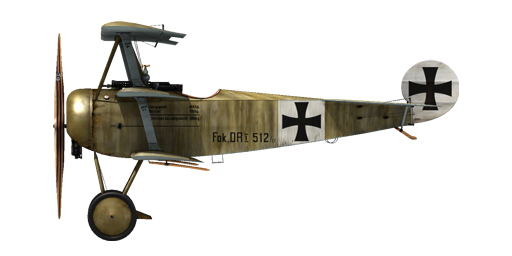il2
Fokker Dr.I

Description
In the spring of 1917, during a visit to Jasta 11, Anthony Fokker inspected the construction of a captured British fighter, the Sopwith Triplane. Manfred von Richthofen related to Fokker the details of his dogfight with this new aeroplane. It was only due to his great experience that the Red Baron managed to avoid defeat.
The prototype of the F.I (the name at the time of the Dr.I) triplane was made ready by August 1917. Some remarkable details of its construction were as follows: a steel tube fuselage frame, as well as metal frames for the stabilizer and tail fin; an absence of bracing trusses; and the placement of the ailerons on the upper wing. The plane was more compact and robust than the British Sopwith Triplane. In total, 320 Dr.I triplanes were built.
On the 23rd of September 1917, Werner Voss shot down two British fighters while piloting an experimental version of the plane. Soon afterwards, he was attacked by six SE5s of the Royal Flying Corps. Each British plane was damaged in the course of this dramatic and historic fight, which forced two of their number to retire from the battle. It was only because he was outnumbered that the ace Voss unfortunately lost his life.
By October 1917, the first production Fokker Dr.I planes were being delivered to fighter squadrons.
The Fokker Dr.I triplane was a superb fighter, but it was rarely used to cover two-seater recon planes.
Dr.I pilots reported an excellent rate of climb and manoeuvrability and a good view from the cockpit. Pilots reported, “You need only a light touch to swing this plane around!” Thanks to these features, the triplane pilot could decide whether to disengage from an attacking enemy or to attack an enemy plane. It could engage on even terms the king of the dogfight, the British Sopwith Camel, with a good chance of victory.
RFC pilots were especially apprehensive of situations where the Fokker Dr.I and the Albatros D.Va were flying together in combat formation. The Fokkers would initiate the dogfight and the Albatros pilots would shoot down enemy planes attempting to disengage and leave the battle.
By the spring of 1918, the plane was obsolete. Only the most outstanding German aces, masterfully piloting the plane and sharpshooting their enemies, continued to fly the triplane in combat.
Engine
Oberursel UR II rotary 9 cyl. 110 hp
Dimensions
Height: 2950 mm
Length: 5770 mm
Wing span: 7190 mm
Wing surface: 18,66 sq.m.
Weight
Empty weight: 388 kg
Takeoff weight: 571 kg
Fuel capacity: 72 l
Oil capacity: 20 l
Maximum airspeed (IAS)
sea level — 169: km/h
1000 m — 161 km/h
2000 m — 153 km/h
3000 m — 144 km/h
4000 m — 136 km/h
5000 m — 127 km/h
6000 m — 118 km/h
7000 m — 108 km/h
8000 m — 94 km/h
Climb rate
1000 m — 3 min. 15 sec.
2000 m — 6 min. 38 sec.
3000 m — 10 min. 35 sec.
4000 m — 15 min. 20 sec.
5000 m — 21 min. 17 sec.
6000 m — 29 min. 09 sec.
7000 m — 40 min. 55 sec.
8000 m — 64 min. 33 sec.
Service ceiling 7900 m
Endurance(h.,min.) at 1000m
nominal power (combat) — 1 h. 40 min.
minimal consumption (cruise) — 2 h. 30 min
Armament
Forward firing: 2xLMG 08/15 Spandau 7.92mm, 500 rounds per barrel
References
1) Fokker Aircraft of WW I, by Paul Leaman, The Crowood Press.
2) Fokker Dr.I, Windsock Datafile Special, Albatros Publications.
3) Fokker Triplane, Windsock Datafiles 5.
3) Fokker Dr1, website www.fokkerdr1.com.
4) Archive “Fokker—Team—Schorndorf”, www.collectors—edition.com.
5) Fokker Dr.I Aces of World War I, by Norman Franks and Greg VanWyngarden.
6) Fokker Dr.I in action, by H J Nowarra, Aircraft Number 68.
7) The Fokker Dr.I, Profile publications, Number 55.
8) The Fokker Triplane, Magazine “FLIGHT” 14 March 1918.
Modifications
Bullet Counters
Wilhelm Morell needle scale Bullet Counters for 2 machine guns
Additional mass: 1 kg
Collimator Night
Oigee Reflector-type Collimator sight (daytime dimmer removed)
Additional mass: 2 kg
Inclinometer
D.R.G.M liquid Inclinometer (indicates bank while on ground and sideslip while in flight)
Additional mass: 1 kg
Collimator Day
Oigee Reflector-type Collimator sight (daytime dimmer installed)
Additional mass: 2 kg
Cockpit light
Cockpit illumination lamp for night sorties
Additional mass: 1 kg
Gunsight
Additional sight with front sight and rear sight mountings
Additional mass: 1 kg